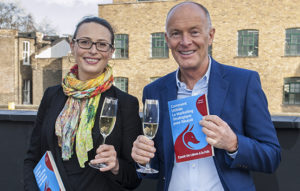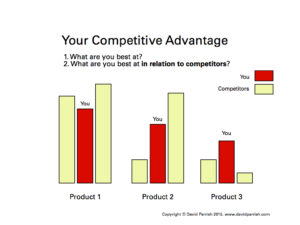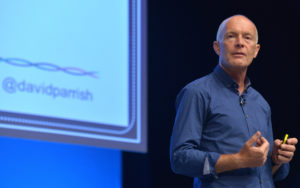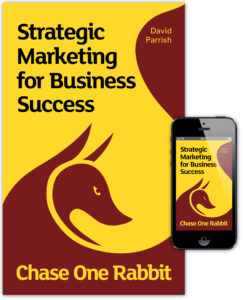What’s your Competitive Advantage?
Knowing what you can excel at in relation to competitors – and then building your business strategy around that focus – is probably the most important element of any successful business strategy.
If you are competing in a market place by offering the same thing as many other rivals, then you can only compete on price: it’s a buyer’s market and prices will fall. This is the case for many creative businesses that do not succeed commercially. On the other hand, prices rise in a seller’s market, with a monopoly being the strongest position to achieve in relation to customers. A profitable strategy shifts your position from one of price competition towards a monopoly position. You can then raise your prices.
How do you do this? By focusing on a product or service that you can deliver and rivals cannot. Yes, for that product there is a smaller demand, but you are much more powerful in that particular market because there is even less supply. Our herd instinct is to follow others into bigger markets where there is more demand, but here there is also excess supply, so it’s a buyer’s market and prices fall.
Focusing on your unique strengths and NOT following the crowd is counter-intuitive but strategically intelligent. Your difference is your strength! Focus on how you are different and build your business around this strength. Not every potential customer will want this, but those who do will love you and pay the right price.
Competitive Advantage is a key element in my business advice consultancy work and my business strategy workshops such as ‘Designing Your Creative Business‘. It’s also one of the themes of my article ‘Create Your Own Business Formula‘. I’ve also written about Competitive Advantage in my books.
Below is an extract from my strategic marketing Book ‘Chase One Rabbit: Strategic Marketing for Business Success. 63 Tips, Techniques and Tales for Creative Entrepreneurs’:
===
Felipe manages a small video production company in Bogotá, Colombia. When I asked him what his business excels at, he quickly said, ‘music videos’ and told me about the excellent videos they’d produced for rock bands. He told me they also make corporate videos and videos for community groups with subtitles used for speakers of foreign languages.
My next question was to ask Felipe what could they do well that rivals couldn’t. We soon recognised that hundreds of other companies also produce excellent music videos, so his company can’t dominate that market. However, very few rivals can produce community-based documentary videos with more than one language involved. In fact, it turned out they are one of the few best firms making multilingual documentaries. Although they excel at music videos, they don’t stand out from the crowd in this market. They do not excel in relation to the competition. Where they do excel in relation to rivals is in the multilingual documentary business. This is where they have competitive advantage.
At what can you excel? Or more precisely, at what can you excel in relation to competitors?
It makes perfect sense to focus on the areas in which you have competitive advantage – to do only those things at which you can excel in relation to competitors. In this way you are competing on your own terms, choosing your battles, and dealing with rivals from a position of strength.
This competitive advantage may be technical, for example, expertise in a particular business area that others do not have. On the other hand, competitive advantage may derive from infrastructure, systems, logistics, or economies of scale that cannot be replicated easily by rivals. For example, wide distribution networks, detailed information about sales trends, production capacity or rapid delivery can provide a competitive advantage over rivals for particular businesses.
Your competitive advantage may be also derived from social connections or status. It may be that you are well respected in a particular community, or have connections in all the right places in a certain industry, or can relate better than rivals to a particular group of customers because of cultural, language, or other affiliations. This is especially the case in businesses where personal relationships matter.
The majority of businesses managed by creative people and selling products derived from that creativity depend on personal relationships. The more closely the customer is involved with the business owners, the more important these personal relationships become. This social advantage doesn’t matter in businesses that are purely impersonal.
In other words, it’s unimportant when transactions and business can take place without needing to interact with other people, and without it being in the slightest bit important that you know, like, or trust them. The more the customer needs to know, like and trust you, the more we need to emphasise people and the ‘personality’ of the business in our marketing strategy and communications.
We cannot recognise where we have competitive advantage unless we analyse our competitors.
This is crucial because we need to base our marketing strategy on our competitive advantage. That’s to say, if we want to focus on the things we can do better than our rivals, we need to know what our rivals are good at, not so good at, and how we can outmanoeuvre them.
‘Know your enemy’ is a fundamental principle of warfare and similarly in business we need to know who we’re up against, which fights we’ll never win, and which battles we can win. Jack Welch, CEO of the General Electric Company, talked about how you have to be paranoid to survive. I’m not advocating paranoia but it is in our interest as business people to be aware of our competitors’ movements, their strengths and their relative weaknesses, so that we can find the best ways in which we can compete amongst them in a crowded marketplace. Market research can also include finding out about competitors’ relative strengths and weaknesses as well as customers’ needs.
So, competitive advantage can be based on expertise, business structure or social connections. This is the key to dominating a market. When you dominate a market it changes the power balance between you and your customers, which then affects the price you can charge.
If you are one of many supplying the market with similar products, your only option is to drop your prices. On the other hand, if you stand out from the crowd you will be in demand, and able to increase prices. It’s all about supply and demand and the relationship between these two things.
A large market may seem attractive, but if there’s an even larger supply, then it’s a buyer’s market. On the other hand, a smaller market but with even fewer suppliers works to the advantage of suppliers. It’s better to be a big fish in a small pond than a small fish in a big pond: small fish get eaten by bigger fish, and businesses without a competitive advantage fail.
===
I’ve also written about Competitive Advantage in my book ‘T-Shirts and Suits: A Guide to the Business of Creativity’, which is available as a paperback and as a free eBook in various formats.
Here’s how I explain Competitive Advantage in ‘T-Shirts and Suits’, using the metaphor of fell running (the British sport of running up and down mountains: ‘fells’):
===
One of the questions to answer is: “What can we do better than our competitors?” Ironically this might not be what you are best at! Competitive Advantage is found in that area where you beat your competitors hands-down – even if it’s not your best skill, or the thing you enjoy the most.
The analogy I use here is about my fell running. I run faster downhill than uphill (obviously) but so does everyone else! Running uphill is slower and more painful – but it is for my competitors too. In the uphill stage I can finish near the front of the pack but I’m slower than average running down. So maybe I should compete in Italy where fell races finish at the top, because there my combination of strengths and weaknesses would give me a competitive advantage.
Thinking about competitive advantage in this way and focusing on customers’ needs at the same time, the question becomes: “Which customers’ problems can we solve better than anyone else?”
Business strategy – your route to success – involves deciding what specifically to do, and with which customers. It also involves deciding what not to do, including deciding which markets not to compete in because the competition is too strong, concentrating instead on areas where you have competitive advantage. Selecting the right customers needs to be done in the context of competitors.
Competitive Positioning is the technique of analysing where you currently fit in amongst competing businesses, deciding where you should be and identifying your own ‘high ground’ on the competitive battlefield.
===
Devising a creative business plan based on competitive advantage will lead to higher prices and greater profitability. It works the other way too: raising your prices will force you to compete only in markets where you have competitive advantage, because nobody will pay you a higher price for things that rivals can deliver equally well.
Key Points
Doing what many others can do better than you is a recipe for failure. It’s not what you are good at that matters; it’s what you are good at that rivals aren’t that gives you a competitive advantage. This competitive advantage allows you to dominate a market – even if it’s a small market – and increase prices.
What to do next
* Analyse competitors through market research in order to find your competitive advantage. Choose a market that you can make your own.
* Make a list of all your competitors and note the things they can do better than you. Through a process of elimination, identify what you can do better than all (or most) of them.
Download this article as a PDF
A special edition of this article was written for Creative Hub Switzerland and published in English, German, French and Italian.
David is a member of the International Advisory Council of Creative Hub Switzerland.
This is an extract from David’s marketing book ‘Chase One Rabbit: Strategic Marketing for Business Success. 63 Tips, Techniques and Tales for Creative Entrepreneurs’.
Read this and 62 more inspiring and practical marketing techniques on your smartphone by downloading this strategic marketing book as an eBook. It is also available as a paperback and as an Audiobook. This highly-acclaimed marketing book is also available in Spanish and French.
David Parrish is a marketing speaker, author and consultant. He works worldwide helping businesses to become even more successful by using the best strategic marketing techniques.



